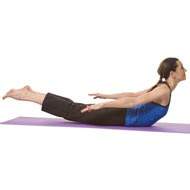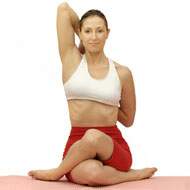Beware the Locust Pose
Salabhasana or the Locust Pose is a type of backbend that is usually performed as part of a sequence of asanas that work the muscles of the back, chest, and legs. To practice this posture:
- Lie down on your stomach with your chin on the floor.
- Place your arms alongside your body with the palms facing upwards.
- Now slowly lift your head, upper torso, arms and legs of the floor.
- Only your abdomen and lower ribs should be on the mat.
- Hold this pose for 30 seconds and return to the starting position.
One of the more challenging of asanas, when performed correctly, the Locust Pose uses the muscles of the lower back, stomach, and legs to lift the entire body off the floor. It helps strengthen and tone the muscles, cleanse the kidneys, improve digestion, relieve stress and increase flexibility. While this pose can be extremely stimulating and beneficial, it is often very difficult to perform, as it requires you to turn your body outwards and upwards in an unnatural manner. Many beginners may find this pose especially challenging, as their muscles are not yet strong enough to hold the posture. To make this pose easier for beginners, many teachers recommend that you lift only one leg at a time and hold the pose. If you have difficulty in lifting your torso off the floor, you can push your hands against the floor to help. For intermediate students, the Locust Pose can improve the strength and tone of the arm and leg muscles by lifting higher and holding the pose for longer periods of time. As an advanced student, the Locust Pose can be made dynamic by lifting your legs up and down slowly for the duration of the asana.
However beneficial the Locust Pose may be, there are certain precautions that should be taken.
- Over-stretching your back while practicing the pose can lead to serious back injury. If you do suffer from back or neck pain, perform the Locust Pose only under the supervision of an experienced yoga instructor. People with serious back or spinal injuries should avoid this pose completely.
- Since the Locust Pose puts extra pressure on the abdomen, it is recommended that people suffering from peptic ulcers and pregnant women avoid this pose.
- Many yoga teachers suggest that people with high blood pressure and major cardiovascular problems avoid this pose as well since the asana increases blood flow and may put undue pressure on the heart.
Read more articles from the Yoga and disease Category.

 Find Pose
Find Pose

